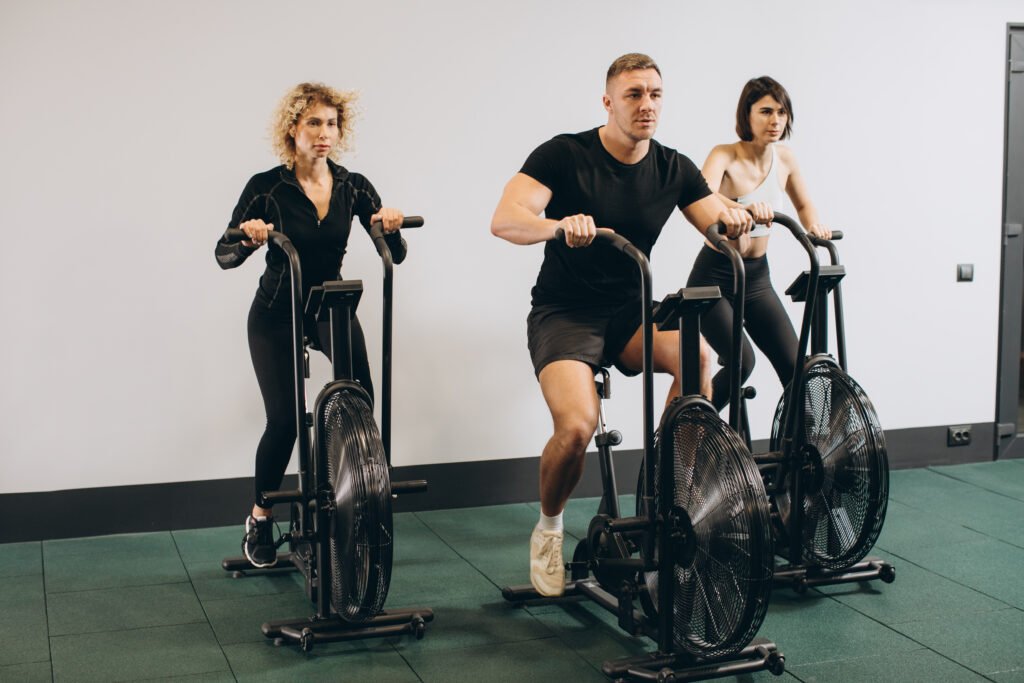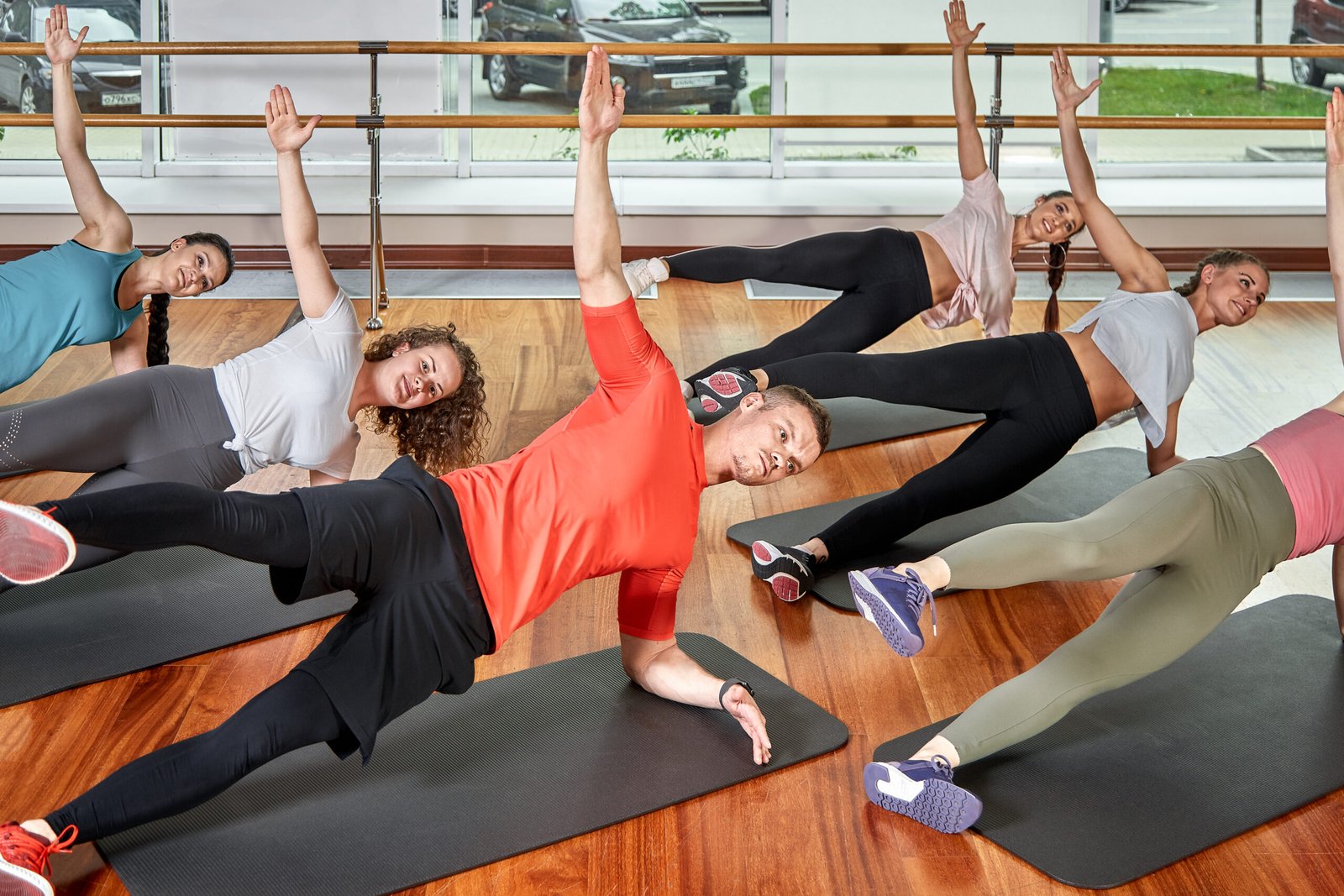Taking the plunge into an active lifestyle can do wonders for your heart, and the journey to improved cardiovascular health begins with simple steps. For beginners, understanding “Cardio for Beginners: How to Start Your Journey to a Healthier Heart with Simple Steps!” is key to achieving lasting success. In this blog post, we will explore effective strategies to transform your heart health, focusing on easy steps to kickstart your cardio journey. From initial health assessments to enjoyable at-home workouts, these insights will empower you to embrace a heart-healthy lifestyle.
8 Easy Steps to Start Exercising for a Healthy Heart
Begin with a Comprehensive Health Check-Up
| Factor | Description | Importance |
|---|---|---|
| Cholesterol Levels | Measures total cholesterol, LDL (bad) cholesterol, and HDL (good) cholesterol. | Critical for assessing risk of heart disease; high cholesterol can lead to plaque buildup in arteries. |
| Blood Pressure | Measures the force of blood against artery walls. | High blood pressure increases heart disease and stroke risks. |
| Body Mass Index (BMI) | A measure of body fat based on height and weight. | Obesity is a significant risk factor for cardiovascular disease. |
| Blood Glucose Levels | Measures the sugar levels in the blood. | High blood sugar levels can indicate the risk of diabetes, which is linked to heart disease. |
| Resting Heart Rate | Measures how many times the heart beats per minute at rest. | A lower resting heart rate indicates better heart efficiency and fitness. |
| Family History | Review of any genetic predispositions to heart disease. | Helps assess personal risk level for heart-related conditions based on family medical history. |
To embark on your new exercise regimen safely, starting with a comprehensive health check-up is crucial. Consulting with your doctor can provide valuable insights into your current heart health, enabling you to understand any potential risks associated with starting a cardio routine. A trusted healthcare professional can assess your cholesterol levels, blood pressure, and overall cardiovascular condition, offering tailored advice on suitable exercises and intensity levels. This preventive measure ensures that your journey toward heart health is safe and effective.
– Schedule a health screening for an overall check-up.
– Discuss your fitness goals and potential limitations with a healthcare professional.
– Obtain personalized exercise recommendations to safely improve heart health.
Taking the time to go through a health check promotes a mindful approach to fitness, setting a strong foundation for a healthy transition into a more active lifestyle.
Set Realistic and Achievable Fitness Goals
| Goal | Details | Timeline | Expected Outcome |
|---|---|---|---|
| Walk 10,000 Steps Daily | Begin by tracking your daily steps and gradually increase to reach 10,000 steps. | 1 month | Improved cardiovascular endurance and lower body strength. |
| Complete Three 30-Minute Walks Per Week | Set days for regular walking, increasing distance as you feel more comfortable. | 2 weeks | Better stamina and a noticeable increase in energy levels. |
| Cycle for 30 Minutes, Twice a Week | Start with steady cycling sessions on flat terrains, focusing on form and rhythm. | 3 weeks | Enhanced leg strength, endurance, and heart health. |
| Attend 1 Dance Class Per Week | Engage in fun and rhythmic dance routines that elevate heart rate and promote flexibility. | 1 month | Increased cardiovascular endurance and flexibility. |
| Track Progress on a Fitness App | Use apps or fitness trackers to monitor your workout progress and keep motivation high. | Ongoing | Continuous tracking will help you stay on track and celebrate achievements. |
Setting realistic and achievable fitness goals is vital in fostering motivation and staying focused on heart health improvement. Goals give your workouts direction, helping you measure progress and celebrate milestones. Instead of vague aspirations, such as “get fit,” establish specific objectives like walking 10,000 steps daily over a month. By remaining pragmatic and self-aware, you can push yourself just the right amount to foster cardio health without overwhelm or injury.
– Define clear and attainable short-term goals (e.g., walk three times a week).
– Tie fitness goals to positive results, like increased energy or better stress management.
– Anticipate and plan for potential challenges (time constraints, lack of motivation).
Achieving these realistic goals will provide satisfaction and reinforce your dedication, making it easier to maintain momentum on your journey to better heart health.
Start with Low-Intensity Exercises
| Exercise | Description | Benefits | Suggested Duration/Frequency |
|---|---|---|---|
| Walking | Start with brisk walking sessions, focusing on a steady pace. | Increases cardiovascular health, improves circulation. | 20-30 minutes, 3-4 times per week. |
| Cycling | Engage in low-impact cycling, either indoors or outdoors. | Strengthens legs, boosts cardiovascular function. | 20-30 minutes, 2-3 times per week. |
| Swimming | Full-body exercise, ideal for joint concerns. | Builds endurance, tones muscles, and enhances heart health. | 30 minutes, 2-3 times per week. |
| Yoga or Stretching | Gentle stretching or yoga for flexibility and relaxation. | Reduces stress, improves flexibility, and helps recovery. | 15-20 minutes, 2-3 times per week. |
Commencing with low-intensity exercises like walking or cycling can gradually build your stamina without overwhelming your body. These activities require minimal equipment or training, making them accessible for any beginner. As you consistently partake in these exercises, your endurance will gradually improve, and you’ll become more confident in your abilities.
– Begin walking sessions for 20-30 minutes at a comfortable pace.
– Explore cycling on flat terrains, focusing on steady and rhythmic pedaling.
– Track progress through an app or fitness tracker to monitor improvements.
Incorporating these gentle activities into your routine lays the groundwork for a sustainable exercise habit, making it easier to integrate more challenging workouts in the future.
Incorporate a Variety of Exercises
| Exercise | Type of Activity | Key Benefits | Suggested Frequency |
|---|---|---|---|
| Swimming | Cardiovascular, Full-body | Enhances heart function, tones muscles, low-impact. | 2-3 times per week |
| Dancing | Cardiovascular, Fun | Elevates heart rate, improves flexibility and mood. | 2-3 times per week |
| Cycling | Cardiovascular, Lower-body | Boosts endurance, strengthens legs and lungs. | 3-4 times per week |
| Walking | Cardiovascular, Low-impact | Improves circulation, suitable for all fitness levels. | 4-5 times per week |
| Jump Rope | Cardiovascular, Coordination | Improves heart health, burns calories quickly. | 2-3 times per week |
Enhancing your workout routine with various exercises, like swimming or dancing, keeps sessions lively and stimulating. Different activities target different muscle groups and aspects of fitness—such as flexibility, strength, and coordination—creating a holistic approach to your heart health journey. You’re more likely to stay engaged and committed by adding these enjoyable experiences to your regimen.
– Alternate between swimming laps and attending dance classes to diversify workouts.
– Explore beginner-friendly fitness apps or online tutorials for fresh exercise ideas.
– Rotate new activities weekly to maintain excitement and prevent monotony.
A varied routine not only bolsters motivation but also optimizes the benefits of cardiovascular training for overall heart health.
Maintain Consistency by Scheduling Workouts
| Week | Activity | Intensity | Duration | Goal |
|---|---|---|---|---|
| Week 1-2 | Walking or cycling (low intensity) | Low | 20-30 minutes | Establish a routine, 3-4 sessions per week. |
| Week 3-4 | Add moderate-intensity walking | Moderate | 30-40 minutes | Increase workout time or intensity. |
| Week 5-6 | Combine walking and swimming or dancing | Moderate | 30-45 minutes | Diversify exercises to maintain excitement. |
| Week 7-8 | Increase cycling duration | High (Optional) | 45-60 minutes | Achieve consistency, aim for 4-5 sessions per week. |
Consistency is critical when building a workout habit; therefore, scheduling your workouts and finding a workout buddy can help you stay accountable. Regularity reinforces discipline and commitment, transforming your fitness goals into reality. Penning predetermined workout slots into your daily or weekly schedule can help prevent procrastination and keep you on track toward heart health.
– Set specific days and times for workouts to make exercise a non-negotiable part of your routine.
– Recruit a reliable workout buddy to encourage mutual accountability.
– Use shared fitness calendars or reminder apps to solidify your commitment.
Consistency fosters a vital exercise foundation, ensuring you experience gradual yet significant improvements in cardiovascular health.
Creating the Perfect Cardio Workout for Your Heart
Start with Low-Intensity Exercises
When crafting a cardio routine, beginning with low-intensity exercises eases you into the habits necessary for building endurance. These exercises provide a gentle introduction to cardiovascular activities, increasing your heart rate without eliciting excessive strain. As you incorporate these activities into your routine, they’re vital in fostering lasting stamina and sustained energy, key contributors to heart health.
– Start with brisk walking sessions to gradually elevate your heart rate.
– Integrate short, low-impact cycling sessions to enhance endurance.
– Gradually increase duration or intensity as comfort and ability improve.
Such gradual progression allows your body to adapt efficiently, maintaining enthusiasm without suffering from burnout, soreness, or injury.
Include a Mix of Activities
Opting for a deliberate blend of activities such as brisk walking, cycling, or swimming ensures your workouts remain engaging and well-rounded. Mixing exercises addresses various fitness components, such as cardiovascular endurance, strength, and flexibility, resulting in a comprehensive regime. You’re likelier to stay motivated by keeping workouts engaging and satisfying for your body and mind.
– Plan weekly schedules with allocated days for different exercises (e.g., Monday swimming, Wednesday cycling).
– Try outdoor hiking or cycling to introduce a change in environment along with effort.
– Gradually incorporate new exercises or variations to maintain excitement.
Embracing diversity in your routine supports consistent practice, ensuring a well-rounded approach to improved cardiovascular health.
Aim for Recommended Physical Activity Levels
Health experts recommend hitting a weekly target of at least 150 minutes of moderate aerobic activity for optimal heart health. Focusing on this benchmark ensures you’re dedicating sufficient time to meaningful activities that benefit your cardiovascular system. This guideline serves as a helpful framework for creating an effective workout routine, offering clear indications of your progress.

– Break weekly sessions into manageable 30-minute chunks, 5 times a week.
– Plan group workout activities, like team sports or community fitness classes.
– Monitor activity duration and exertion levels using a fitness tracker or app.
By aspiring to this target, you maintain a responsive heart and body, yielding long-term positive impacts on your health.
Prioritize Consistent Practice Over Intensity
In your cardio journey, prioritizing consistency over intensity is fundamental to cultivating inclusivity and sustainable progress. It’s tempting to push hard for quick results; however, long-term heart health benefits stem from dedication and steady advancement. Consistent practice fuses exercise with everyday habits, fostering durability and enjoyment without pressuring quick gains.
– Focus on developing an exercise routine first, rather than immediate intensity increases.
– Invest energy in adjusting and perfecting form for optimal results.
– Set progressive challenges that ensure health-conscious growth.
By emphasizing continuity, beginners engage in pleasant, meaningful workouts—building a permanent foundation of cardiovascular resilience.
Listen to Your Body and Allow Adequate Rest
Listening to your body and incorporating sufficient rest and recovery safeguards you from over-exertion, which could otherwise undermine your heart health efforts. Regular breaks prevent fatigue and injury, enabling your body to rebound stronger after exertion. Balancing effort and rest is integral to your long-term sustainability and welfare.
– Implement rest days within your weekly workout schedule to promote recovery.
– Observe how your body responds to physical exertion, adapting your routine accordingly.
– Incorporate gentle stretching sessions during rest or recovery periods to maintain flexibility.
This balanced approach nurtures longevity in your cardio routine, paving the way for continuous progress and heart health benefits.
10 Easy Heart-Healthy Exercises You Can Do at Home: No Equipment Needed
| Exercise | Description | Target Area | Benefits | Duration/Frequency |
|---|---|---|---|---|
| Jumping Jacks | A full-body exercise that elevates the heart rate. | Full Body | Increases cardiovascular endurance, burns calories, and improves coordination. | 1-2 minutes per session, 3-4 times a week |
| Stair Climbing | Climb up and down a flight of stairs or use a step. | Lower Body (Legs) | Strengthens the lower body, improves heart function, and burns calories. | 3-5 minutes, 3-4 times a week |
| High Knees | Stand in place and alternate lifting knees to chest at a quick pace. | Core, Legs, and Cardiovascular System | Boosts heart rate, improves leg strength, and enhances cardiovascular endurance. | 1-2 minutes per session, 3-4 times a week |
| Fast Feet | Rapidly alternate stepping feet as if running in place, staying low to the ground. | Legs, Core | Increases heart rate, strengthens legs and core, and improves agility. | 1-2 minutes per session, 3-4 times a week |
| Imaginary Jump Rope | Mimic the movement of jumping rope without the actual rope. | Full Body, Core, and Legs | Improves coordination, balance, and cardiovascular endurance. | 1-2 minutes per session, 3-4 times a week |
| Squats | Lower your body into a sitting position and return to standing. | Lower Body (Legs) and Glutes | Strengthens legs, glutes, and core, while boosting circulation. | 10-15 reps, 3-4 sets, 3-4 times a week |
| Lunges | Step forward with one leg, lower the body, and return to standing. | Lower Body (Legs and Glutes) | Tones the legs, improves balance, and strengthens the cardiovascular system. | 10-12 reps per leg, 3 sets, 3-4 times a week |
| Push-ups | Begin in a plank position, lower the body to the floor, and push back up. | Upper Body (Chest, Arms, Core) | Strengthens upper body, improves endurance, and helps maintain cardiovascular fitness. | 10-15 reps, 3 sets, 3-4 times a week |
| Mountain Climbers | From a plank position, alternate bringing knees toward the chest quickly. | Full Body (Core, Legs, Cardiovascular) | Boosts heart rate, tones the core, and strengthens the arms and legs. | 1-2 minutes per session, 3-4 times a week |
| Dance Your Way to Fitness | Move freely to music, incorporating dance moves or aerobics. | Full Body, Core | Boosts heart rate, enhances flexibility, and reduces stress. | 20-30 minutes, 2-3 times a week |
Highlight the Importance of Starting a Cardio Routine for Heart Health
Beginning a cardio routine for heart health is essential, especially at home, where convenience and ease are paramount. When initiating your fitness journey, establishing a home-based exercise foundation allows you to progressively enhance cardiovascular health without excessive investments in equipment or gym memberships. With consistency and determination, these straightforward exercises efficiently target heart health improvement.
– Consider space-efficient exercises adaptable to any living area.
– Focus on exercises that demand minimal equipment and are versatile for all fitness levels.
– Prioritize high-impact results by dedicating time and persistence to your routine.
By adopting these straightforward activities, novices gracefully enter the fitness realm, laying the groundwork for enhanced cardiovascular performance.
Introduce 10 Easy, Heart-Healthy Exercises
At-home exercise options empower individuals to incorporate heart-healthy routines effortlessly, providing attainable means to improve cardiovascular fitness. Through time and dedication, these exercises collectively contribute to improved circulation and endurance, optimally affecting overall heart function.
– Incorporate Jumping Jacks: Elevate heart rate while targeting major muscle groups.
– Practice Stair Climbing: Strengthen muscles and lungs without additional equipment.
– Engage in High Knees: Enhance cardiovascular endurance and strengthen core and lower body muscles.
– Perform Fast Feet: Rapidly improve heart rate and cardiovascular endurance with minimal space.
– Try Imaginary Jump Rope: Core-focused cardio promoting balance and rhythm without equipment.

– Master Squats: Strengthen lower body muscles and improve overall circulation.
– Add Lunges: Foster strength in key muscle groups, boosting stability and resilience.
– Conquer Push-ups: Enhance endurance while focusing on upper body and core strength.
– Incorporate Mountain Climbers: Elevate heart rate effectively through dynamic movement.
– Dance Your Way to Fitness: Boost circulation and flexibility through upbeat, stress-relieving activity.
These accessible routines cater to various fitness levels, ensuring that anyone initiating their heart-health journey gains maximum benefits.
Emphasize the Convenience and Accessibility
With easy home-based exercises, adapting your cardiovascular routine to individual needs becomes intuitive, promoting an adaptable approach to heart health. Their inherent convenience ensures adherence, particularly in accommodating unpredictable schedules. Moreover, with zero equipment needed, these exercises empower individuals to begin their cardio journey anytime, anywhere.
– Fit exercises into your daily routine without major time commitments.
– Adjust exercise intensity or duration to accommodate time-packed schedules.
– Select exercises that double as stress-relief methods, merging productivity with emotional wellness.
Home-friendly workouts enable beginners to seamlessly integrate cardiovascular activities into busy lives, safeguarding heart health even amidst hectic schedules.
Encourage Consistency and Gradual Progression
By championing consistency and gradual progression, novices steadily enhance cardiovascular health with durability and enthusiasm. Building habits at a suitable pace ensures both immediate and long-term payoffs, weaving subtle success stories into the fabric of their cardio endeavors.
– Aim for incremental developments in workout frequency, duration, or intensity.
– Embed exercises within larger fitness goals for cohesive, goal-oriented plans.
– Celebrate each achievement, however small, to maintain motivation.
Practicing consistent, gradual incorporation of heart-healthy exercises nurtures a sustainable approach to fitness, promoting a lifelong commitment to cardiovascular wellness.
Promote the Benefits of These Exercises
Engaging in these easy cardio exercises yields remarkable benefits, enriching the heart, body, and mind in multiple ways. From bolstering energy levels to enhancing mood and circulation, the advantages of home workouts resound both internally and externally. With patience and perseverance, the tangible improvements make evident the rewards of a dedicated exercise regimen.
– Elevate mood and energy, thanks to the endorphins released during exercise.
– Enhance vascular endurance, promoting hearty, vibrant living.
– Witness strengthened heart muscles, reducing future cardiovascular risks.
– Notice improved balance, flexibility, and coordination through varied activities.
– Benefit from enhancements in overall well-being and quality of life.
By adopting these exercises, you fortify your heart, building lasting vigor and vitality for many happy, healthy years to come.
What are some easy cardio exercises for beginners to improve heart health?
| Exercise | Description | Target Area | Benefits | Recommended Duration/Frequency |
|---|---|---|---|---|
| Walking | A low-impact exercise that involves walking at a brisk pace. | Full Body (Low-Impact) | Improves cardiovascular health, reduces stress, boosts circulation, and helps with weight management. | 20-30 minutes daily, or 3-5 times a week |
| Cycling | Riding a bike (either outdoors or stationary) at a moderate pace. | Lower Body (Legs) | Strengthens the legs, boosts cardiovascular endurance, and burns calories. | 20-30 minutes, 3-4 times a week |
| Swimming | A full-body workout involving laps or water aerobics. | Full Body (Low-Impact) | Tones muscles, enhances heart function, and provides a refreshing, joint-friendly workout. | 30 minutes, 2-3 times a week |
| Jump Rope | A fun exercise that involves jumping over an imaginary rope in rhythm. | Full Body (Legs, Core, Cardiovascular) | Burns calories quickly, improves coordination, and boosts cardiovascular endurance. | 1-2 minutes, with breaks, 2-3 times a week |
| Dancing | Dance to music or follow an aerobic dance routine. | Full Body (Rhythmic Movements) | Increases heart rate, improves flexibility, and lifts mood. | 20-30 minutes, 2-3 times a week |
| Low-Impact Aerobics | Aerobic exercises that avoid jumping or high-impact movements, such as marching. | Full Body (Cardiovascular) | Enhances heart rate, tones muscles, and promotes endurance without strain. | 30 minutes, 3-4 times a week |
| Hiking | Walking on trails, often with an incline or uneven terrain. | Lower Body (Legs, Core) | Improves leg strength, enhances cardiovascular function, and strengthens muscles. | 30-60 minutes, 2-3 times a week |
| Rowing | Using a rowing machine to simulate the action of rowing a boat. | Full Body (Arms, Legs, Core) | Provides a total-body workout, strengthens the heart, and burns calories. | 20-30 minutes, 2-3 times a week |
| Elliptical Trainer | Using a machine that simulates walking or running while reducing impact. | Full Body (Cardiovascular) | Enhances heart function, strengthens the lower body, and minimizes joint stress. | 20-30 minutes, 3-4 times a week |
| Tai Chi | A form of gentle martial arts focusing on slow, deliberate movements. | Full Body (Core, Flexibility) | Reduces stress, improves circulation, and increases flexibility. | 20-30 minutes, 2-3 times a week |
When embarking on a journey to enhance cardiovascular health, it’s crucial to start with exercises that strike a balance between ease and effectiveness. The beauty of cardio exercises lies in their versatility and adaptability, making it simple for beginners to incorporate them into daily routines without overwhelming the body. Here are some highly effective yet gentle exercises that promise to kickstart your heart health journey:
1. Walking
A timeless classic, walking is perhaps the most accessible form of cardio for beginners. It requires no special equipment and can be done virtually anywhere. Starting with a brisk 20 to 30-minute walk daily can significantly boost cardiovascular endurance, improve circulation, and help manage weight. To maximize benefits, focus on maintaining good posture, swinging your arms, and gradually increasing your speed and distance over time.
2. Cycling
Cycling, whether on a stationary bike or outdoors, is an excellent low-impact cardio exercise. It strengthens the lower body while ramping up cardiovascular efficiency. Beginners should aim for 3 to 4 sessions of 20-30 minutes each week. As confidence and endurance build, incrementally increase the intensity or duration. Adjusting the resistance on a stationary bike can also simulate outdoor hills, adding variety to your workout.

3. Swimming
This full-body workout is particularly beneficial for those with joint concerns, as it provides resistance without impact. Swimming engages multiple muscle groups, enhancing cardiovascular function and increasing overall muscle tone. Newcomers can begin with simple laps or water aerobics, progressing at their own pace. Regular sessions of 30 minutes, two to three times a week, can markedly uplift heart health while imparting a refreshing effect.
4. Jump Rope
Rekindle your childhood joy with jumping rope, a highly effective cardio workout that challenges coordination and endurance. Despite its simplicity, jumping rope can burn a substantial number of calories in a short period. Start by aiming for short intervals, such as 1-2 minutes, with rest breaks in between. Gradually build up your stamina to handle longer sessions. This activity not only strengthens the heart but also improves bone density and agility.
5. Dancing
Dancing is more than an artistic expression; it’s a fun and energetic way to enhance heart health. Whether it’s through structured aerobic dance classes or freestyling in the comfort of your home, dancing elevates the heart rate, boosts mood, and improves flexibility. Engage in dancing for 20-30 minutes a few times a week. It’s an enjoyable way to maintain a fitness regime, making it easier to stay consistent.
6. Low-Impact Aerobics
Aerobics classes geared towards beginners focus on low-impact movements that enhance heart rate without straining the body. These sessions often include a variety of exercises like marching, step tapping, and side leg lifts, making them dynamic and engaging. Consistent participation can significantly improve cardiovascular health, strengthen muscles, and boost overall endurance, making it an ideal starting point for beginners. By sharing your progress and experiences through social media or fitness blogs, you can inspire others embarking on their cardio journey while enhancing your own accountability. Additionally, integrating short, informative videos or infographics detailing proper techniques and benefits into your blog can attract more readers and improve engagement. Harmonizing these elements ensures your post ranks higher in search results, ultimately driving more traffic to your blog and fostering a community of fitness enthusiasts eager to cultivate a healthier heart with simple steps.
What are the benefits of starting a cardio routine for heart health?
| Cardio Exercise | Target Area | Key Benefits | Recommended Duration | Frequency |
|---|---|---|---|---|
| Walking | Full Body (Low-Impact) | Improves cardiovascular health, increases circulation, helps with weight management, and reduces stress. | 20-30 minutes | 3-4 times per week |
| Cycling | Lower Body (Legs) | Strengthens the lower body, enhances cardiovascular endurance, and is low-impact on joints. | 30 minutes | 3-4 times per week |
| Swimming | Full Body | Full-body workout, ideal for joint health, increases heart function, and tones muscles. | 30-45 minutes | 2-3 times per week |
| Jump Rope | Full Body (High Intensity) | Boosts cardiovascular endurance, burns calories quickly, improves coordination and balance. | 1-2 minutes per session (with breaks) | 3 times per week |
| Dancing | Full Body (Rhythmic Movements) | Increases heart rate, improves flexibility, and reduces stress. It is enjoyable and easy to stick with. | 20-30 minutes | 2-3 times per week |
Adopting a cardio routine can be transformative for your heart health, providing a multitude of benefits that extend beyond mere physical fitness. Cardio exercises include any activity that raises your heart rate, such as walking, running, cycling, or swimming. By engaging in regular cardiovascular activities, you can experience several key advantages that promote a stronger and healthier heart.
1. Improved Heart Efficiency
A consistent cardio routine trains your heart to pump blood more efficiently. Over time, your heart becomes stronger and more adept at delivering oxygen-rich blood to all parts of your body. This enhanced efficiency reduces the strain on your heart and lowers your resting heart rate, a sign of good heart health.
2. Lower Blood Pressure
Cardiovascular exercises help in dilating blood vessels, which facilitates smoother and easier blood flow. This process can lead to a decrease in systolic and diastolic blood pressure, thereby minimizing the risk of hypertension—one of the major risk factors for heart disease.
3. Enhanced Cholesterol Profile
Regular cardio activity is known to boost levels of high-density lipoprotein (HDL), also known as the “good” cholesterol, while decreasing levels of low-density lipoprotein (LDL), or the “bad” cholesterol. An improved cholesterol profile reduces the risk of plaque buildup in your arteries, which is critical to maintaining a healthy cardiovascular system.
4. Weight Management
Cardio exercises are effective at burning calories and can significantly contribute to weight loss or weight maintenance. By managing your weight, you lower your chances of obesity, which is a major risk factor for several heart-related conditions, including coronary artery disease, heart attack, and stroke.
5. Stress Reduction
Physical activity, especially cardio, stimulates the release of endorphins, which are natural mood lifters. This stress-busting benefit not only improves your mental well-being but also protects your heart. Chronic stress is a known risk factor for heart disease, and incorporating cardio can help mitigate its effects.
6. Reduced Risk of Cardiovascular Diseases
Engaging in regular cardiovascular exercise helps improve the elasticity of arteries and veins, making them more adaptable to changes in blood flow. This adaptability reduces the risk of atherosclerosis and other cardiovascular diseases, offering a layer of protection against heart attacks and strokes.
7. Increased Longevity
The cumulative effects of a regular cardio routine contribute to greater overall cardiovascular resilience and enhanced longevity. Studies have shown that individuals who engage in routine aerobic exercise tend to live longer, healthier lives, with a reduced risk of dying from heart disease.
Embracing a cardio routine is not just about staying fit; it’s about investing in your heart’s health, ensuring it remains robust and resilient. Whether you choose brisk walking, cycling, or swimming, each step, pedal, or stroke brings you closer to a healthier heart and a healthier life.
In conclusion, embarking on a cardio journey as a beginner is a rewarding step towards enhancing your heart health and overall well-being. By integrating simple and sustainable activities, setting realistic goals, and gradually increasing your intensity, you can create a fulfilling and enjoyable fitness routine. Remember to listen to your body, stay consistent, and celebrate your progress, no matter how small. With dedication and persistence, the benefits of regular cardio exercise will soon become evident, leading you to a healthier heart and a more energetic lifestyle. As you continue on this path, keep exploring and adapting various cardio exercises to keep your routine fresh and engaging, ensuring that you stay motivated and committed to your fitness journey.













